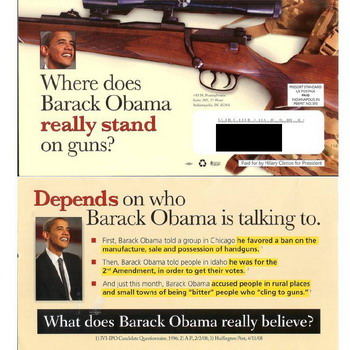
DIRECT MAIL IN ELECTIONS
SELECTED
BIBLIOGRAPHY
Allan Louden, Wake Forest University (louden@wfu.edu)
Last Updated:
Sunday, 05-Oct-2008 11:39:45 EDT

Alexander, H. E., & Bauer, M. (1991). Financing the 1988 elections. : Westview Press.
All mail review (2001). Campaign & Elections, 22, 20-31.
Armstrong, R. (1988). The next hurrah: The communication revolution in American Politics. New York: Beech Tree Books. [see pp. 31-135]
Benoit, W. L., & Stein, K. A. (2005). A functional analysis of presidential direct mail advertising. Communication Studies, 56, 203-225.
Bonafede, D. (1982). Part science, part art, part hokum: Direct mail now a key campaign tool. National Journal, , 1332-1336.
Burde, H. A. (1986). Political direct mail. Politics and Policy, 6, 85-102.
Clinton, W. D., Clinton, A. E. (1999). Telephone and direct mail. In D. D. Perlmutter (Ed.), The Manship School guide to political communication (pp. 137-146). Baton Rouge, LA: Louisiana State University Press.
Collins, T. (1972). McGovern mailings emphasize issues, motivation, $ needs. Direct Marketing, , 26-39.
Cox, J. R. (1983). Direct mail fundraising letters: "Objectifying" arguments in a personal medium. In D. Zarefsky, M. O. Sillars, & J. Rhodes (Eds), Argument in transition: Proceeding's of the Third Summer Conference on Argumentation (pp. 339-351). Annandale, VA: Speech Communication Association.
Craver, R. (1985). The direct mailbox: the tastelessness of success. Campaigns & Elections, 6, 70-72.
Craver, R. M. (1985). Direct mail and the political process. In R. G. Meadow (Ed.), New communication technologies in politics (pp. 69-95). Washington, D.C.: The Washington Program - Annenberg School of Communication.
Cutbirth, C., & Schmidt, M. (1981, November). Direct mail as a rhetorical tool: The conservative campaign of 1980. Paper presented at the meeting of the Speech Communication Association. Anaheim, California.
Cutbirth, C., & Rasmussen, C. (1982, April). Political direct mail: The state of the art. Paper presented at the meeting the the Central States Speech Communication Association. Milwaukee, Wisconsin.
Dommeyer, C. J. (1987). The effects of negative cover letter appeals on mail survey response. Journal of the Market Research Society, 29, 445-451.
Eberle, B. W. (1985). Political direct mail fundraising. Vienna, VA (Self published).
Ford, M. F. (1989, March/April). Dear voter: Wish you were here: Take a vacation from overstuffed mail and send a postcard. Campaigns and Elections, 9, 51.
Gerber, A. S., & Green, D. P. (2000). The effects of canvassing, direct mail, and telephone contact on voter turnout: A field experiment. American Political Science Review, 94, 653-663.
Godwin, R. K., & Mitchell, R. C. (1984). The implication of direct mail for political organizations. Social Science Quarterly, 65, 829-839.
Green D. P. (2003). Mobilizing African-American voters using direct mail and commercial phone banks: A field experiment. Institution for Social and Policy Studies, Yale. http://www.yale.edu/isps/publications/voter.html
Hager, B. (1984). The appeal of the New Right: Jerry Falwell's high-tech/low-road approach. Southern Exposure, 12, 79-85.
Hazelwood, D. N. (1991). Putting on the blitz: Coordinating direct mail with paid media. Campaign Magazine, 5, 24-25.
Heighberger, N. R., & Adler, R. C. (1984, October). Use of direct mail: A campaign based field experiment. Paper presented at eh American Political Science Association Annual Meeting, Washington, D.C.
Heller, D. J. (1987). Mail, money and Machiavelli. Campaigns and Elections, 8, 32-45.
In the Mail. [Regular feature with current examples in monthly editions of Campaign & Elections Magazine.]
Jones, E. (1989). Franking use criticized: Fundraising pitches follow franked, targeted mailings. Campaign Industry News, 3, 1, 26-7.
Kanfer, R. (1991, July). Direct to the bank. Campaigns and Elections, 12, 22-24, 26-27.
Light, L. (1982). Direct mail bids do not ensure pots of gold. Congressional Quarterly, 2714-2715.
Louden, A. D. (1984). Semi-mobilization of the far-right: The rhetoric of direct-mail fund raising. Unpublished paper, University of Southern California.
Luntz, F. I. (1988). Candidates, consultants and campaigns. New York: Basil Blackwood. [See chapter 5. Politics through the mail, pp. 146-167]
Malchow, H. (2001). TV vs. direct mail: Campaign cost comparisons. Campaigns & Elections, 22, 54-56.
Miller, R. E., & Richey, W. M. (1980). The effects of a campaign brochure drop in a county level race for State's Attorney. In D. Nimmo (Ed.), Communication yearbook IV (pp. ). New Brunswick, NJ: Transaction Books.
Miller, R. E., & Robyn, K. L. (1975). A field experimental study of direct mail in a congressional primary campaign: What effects last until election day. Experimental Study of Politics, 4, 1-37.
Mudd, D. (1991, July). How to mail a 60-pound tomato. Campaigns and Elections, 12, 29-37.
Muth, C. (1998, May). How to use direct mail to raise money for any campaign, small or large. Campaigns & Elections, 19, 51-59, 63
Niven, D. (2006). A field experimenton the effects of negative campign mail on voter turnout in a municipal election. Political Research Quarterly, 59, 203-210.
O'Shaughnessy, N. J. (1988). The peevish penmen: Direct mail and US elections. European Journal of Marketing; 22, 36-44,
Olsen, H. (1984/85). Mail box politics. Election Politics, 2, 25-30.
Peterson, B. (1982, November 17). Direct mail writes new chapter in how to run a political campaign. Washington Post, A1-A2.
Persinos, J. F. (1994, June). Pushing the envelope. Campaigns & Elections, 15, 20-25.
Pfau, M., Kenski, H. C., Nitz, M., & Sorenson, J. (1990). Efficacy of inoculation strategies in promoting resistance to political attack messages: Application to direct mail. Communication Monographs, 57, 25-43.
Riley, C. (1987). Direct mail on target. Campaigns and Elections, 7, 40.
Ringer, R. J. (1986). The language of fund-raising direct mail differences between letters for national and local constituencies. Paper presented at the meeting of the International Communication Association. Chicago, Illinois.
Rosenberg, T. (1983, April). Diminishing returns: The false promise of direct mail. Washington Monthly, 32-38.
Rothenberg, S. (1983). Applications of direct mail in voter turnout activities. Paper presented at the meeting of the International Communication Association. Dallas, Texas.
Sabato, L. J. (1984). Mailing for dollars: A political primer on the subtle art of getting you, dear friend, to send money. Psychology Today, .
Schlackman, R., & Douglas, J. (1995, July). Attack mail: The silent killer. Campaigns & Elections, 16, 25-26, 62, 67.
Seinyard, W. R., & Coney, K. A. (1978). Promotional effects on a high-versus low-involvement electorate. Journal of Consumer Research, 5, 41-47.
Snowball, D. (1985, November). Wars, crisis and a fistful of dollars: An ethical evaluation of direct-mail advertising. Paper presented the meeting of the Speech Communication Association. Denver, Colorado.
Viguerie, R. (1981). The New Right: We're ready to lead. Falls Church, VA: The Viguerie Company.
Warwick, M. (1991). Direct-mail fundraising for small campaigns: Money-by-mail is NOT just for household names. Campaign Magazine, 5, 24-26.
Weaver-Lariscy, R. A., & Tinkham, S. F. (1996). Use of impact of direct mail in the context of integrated marketing communications: U.S. Congressional campaigns in 1982 and 1990. Journal of Business Research, 37, 233-244.
Weintz, W. (1987). The solid gold mailbox. New York: John Wiley & Sons.
Weiss, R. (1991). Direct mail: The techno-advantage (What is the future of voter mail). Campaign Magazine, 5, 17-18.
We've got mail, Special
Report (1999). [Most of the issue devoted to direct mail]. Campaigns
and Elections, 20.